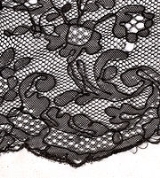
Chantilly lace
Encyclopedia
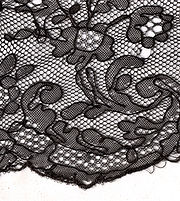
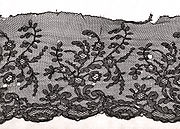
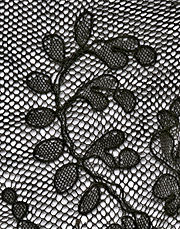
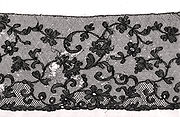
Chantilly lace is a handmade bobbin lace
Bobbin lace
Bobbin lace is a lace textile made by braiding and twisting lengths of thread, which are wound on bobbins to manage them. As the work progresses, the weaving is held in place with pins set in a lace pillow, the placement of the pins usually determined by a pattern or pricking pinned on the...
named after the city of Chantilly
Chantilly, Oise
Chantilly is a small city in northern France. It is designated municipally as a commune in the department of Oise.It is in the metropolitan area of Paris 38.4 km...
, France
France
The French Republic , The French Republic , The French Republic , (commonly known as France , is a unitary semi-presidential republic in Western Europe with several overseas territories and islands located on other continents and in the Indian, Pacific, and Atlantic oceans. Metropolitan France...
, in a tradition dating from the 17th century, though the most famous are silk laces introduced in the 18th century. Though called Chantilly lace, most of the lace bearing this name was actually made in Bayeux
Bayeux
Bayeux is a commune in the Calvados department in Normandy in northwestern France.Bayeux is the home of the Bayeux Tapestry, which depicts the events leading up to the Norman conquest of England.-Administration:Bayeux is a sub-prefecture of Calvados...
in France and Geraardsbergen
Geraardsbergen
Geraardsbergen is a city and municipality located in the Denderstreek and in the Flemish Ardennes, the hilly southern part of the Belgian province of East Flanders. The municipality comprises the city of Geraardsbergen proper and the following towns:...
, now in Belgium.
Chantilly lace is known for its fine ground, outlined pattern, and abundant detail. The pattern is outlined in cordonnet, a flat untwisted strand. The best Chantilly laces were made of silk, and were generally black, which made them suitable for mourning wear
Mourning
Mourning is, in the simplest sense, synonymous with grief over the death of someone. The word is also used to describe a cultural complex of behaviours in which the bereaved participate or are expected to participate...
. White Chantilly lace was also made, both in linen and silk, though most Chantilly laces were made of silk. The black silk Chantilly lace became especially popular, and there was a large market for it in Spain and the Americas. Chantilly and the Spanish laces (such as Blonde lace
Blonde lace
Blonde lace is a continuous bobbin lace from France that is made of silk. The term blonde refers to the natural color of the silk thread. Originally this lace was made with the natural-colored silk, and later in black. Most blonde lace was also made in black. It was made in the 18th and 19th...
) were the most popular black laces. Little white Chantilly was ever {?}made. Another notable thing about Chantilly lace is the use of a half-and-whole stitch as a fill to achieve the effect of light and shadow in the pattern, which was generally of flowers. The background, or réseau, was in the form of a six pointed star, and was made of the same thread as the pattern, unlike the otherwise similar Blonde lace
Blonde lace
Blonde lace is a continuous bobbin lace from France that is made of silk. The term blonde refers to the natural color of the silk thread. Originally this lace was made with the natural-colored silk, and later in black. Most blonde lace was also made in black. It was made in the 18th and 19th...
. The lace was produced in strips approximately four inches wide, and then joined with a stitch that left no visible seam.
Chantilly lace remained popular in the 19th century, when every fashionable lady had a black or white Chantilly shawl, made in Brussels
Brussels
Brussels , officially the Brussels Region or Brussels-Capital Region , is the capital of Belgium and the de facto capital of the European Union...
or Ghent
Ghent
Ghent is a city and a municipality located in the Flemish region of Belgium. It is the capital and biggest city of the East Flanders province. The city started as a settlement at the confluence of the Rivers Scheldt and Lys and in the Middle Ages became one of the largest and richest cities of...
.
History
In the 17th century, the Duchesse de Longueville organised the manufacture of lace at Chantilly. It has been produced from then up until the present day. Owing to the patronage of the duchesse, and the proximity of Chantilly to Paris it became popular. It came into fashion again during the reigns of Louis XV and Louis XVI, and was an especial favorite of Louis XV's last mistress, Mme du Barry, and of Marie AntoinetteMarie Antoinette
Marie Antoinette ; 2 November 1755 – 16 October 1793) was an Archduchess of Austria and the Queen of France and of Navarre. She was the fifteenth and penultimate child of Holy Roman Empress Maria Theresa and Holy Roman Emperor Francis I....
. When the French Revolution
French Revolution
The French Revolution , sometimes distinguished as the 'Great French Revolution' , was a period of radical social and political upheaval in France and Europe. The absolute monarchy that had ruled France for centuries collapsed in three years...
began in 1789, demand for the lace ceased. The lace-makers were seen as protégés of the royals, and after Mme du Barry and Marie Antoinette were guillotined in 1793, the lace-makers of Chantilly were themselves killed. At this point production ceased.
Napoleon I sponsored revivals of Chantilly lace, most especially between the years 1804 and 1815. At this point production was concentrated in Normandy, mainly around the Bayeux area. While it was no longer being made in Chantilly, all of the old techniques and designs were used. Chantilly lace reached the height of its popularity around 1830 and was revived again in the 1860s, at which point it was made at Bayeux, but also at Geraardsbergen
Geraardsbergen
Geraardsbergen is a city and municipality located in the Denderstreek and in the Flemish Ardennes, the hilly southern part of the Belgian province of East Flanders. The municipality comprises the city of Geraardsbergen proper and the following towns:...
in Belgium.
In 1844 a machine was patented that made Valenciennes lace
Valenciennes lace
Valenciennes lace is a type of bobbin lace which originated in Valenciennes, in the Nord département of France, and flourished from about 1705 to 1780. Later production moved to Belgium in and around Ypres. The industry continued onto the 19th century on a diminished scale...
and black silk Chantilly lace that was difficult to distinguish from the handmade lace.

